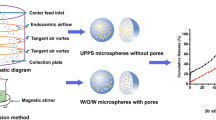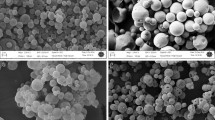Abstract
The effect of the co-lyophilization of bovine serum albumin (BSA) with poly(ethylene glycol) (PEG) on the BSA encapsulation efficiency and formation of soluble BSA aggregates upon solid-in-oil-in-oil (s/o/o) encapsulation in poly(lactic-co-glycolic) acid (PLGA) microspheres was investigated. Suspension of the lyophilized BSA-PEG formulations in methylene chloride produced small protein powder particles of less than 1 μm diam. and this afforded high encapsulation efficiencies of typically ≥90% ameliorating one of the problems in s/o/o encapsulation. Formation of soluble BSA aggregates upon s/o/o encapsulation followed by 24 h in vitro release was between 5% and 22%, much lower than values of 59% reported for BSA without stabilizing excipients. Therefore, PEG also afforded BSA stabilization during s/o/o encapsulation. Sustained release occurred over ca. 2 months and was complete.
Similar content being viewed by others
References
Bittner B, Ronneberger B, Zange R, Volland C, Anderson JM, Kissel T (1998) Bovine serum albumin loaded microspheres: the influence of polymer purity on particle characteristics. J. Microencap. 15: 495–514.
Carrasquillo KG, Cordero RA, Ho S, Franquiz JM, Griebenow K (1998) Structure-guided encapsulation of bovine serum albumin in poly(DL-lactic-co-glycolic)acid. Pharm. Pharmacol. Comm. 4: 563–571.
Carrasquillo KG, Stanley AM, Aponte Carro JC, De Jésus P, Bosques CJ, Costantino HR, Griebenow K (2001) Non-aqueous encapsulation of excipient-stabilized spray freeze-dried BSA into poly(lactide-co-glycolide) microspheres results in release of native protein. J. Controlled Release 76: 199–208.
Castellanos IJ, Carrasquillo KG, De Jésus López J, Alvarez M, Griebenow K (2001a) Encapsulation of bovine serum albumin in poly(lactide-co-glycolide) microspheres by the solid-in-oil-inwater technique. J. Pharm. Pharmacol. 53: 167–178.
Castellanos IJ, Cuadrado WL, Griebenow K (2001b) Prevention of structural perturbations and aggregation upon encapsulation of bovine serum albumin into poly(lactide-co-glycolide) microspheres using the solid-in-oil-in-water technique. J. Pharm. Pharmacol. 53: 1099–1107.
Castellanos IJ, Cruz G, Crespo R, Griebenow K (2002) Encapsulation-induced aggregation and loss in activity of γ-chymotrypsin and their prevention. J. Controlled Release 81: 307–319.
Costantino HR, Carrasquillo KG, Cordero, RA, Mumenthaler M, Hsu CC, Griebenow K (1998) The effect of excipients on the structure and stability of lyophilized recombinant human growth hormone (rhGH). J. Pharm. Sci. 87: 1412–1420.
Costantino HR, Firouzabadian L, Hogeland K, Wu CC, Beganski C, Carrasquillo KG, Córdova M, Griebenow K, Zale SE, Tracy M (2000) Protein spray-freeze drying. Effect of atomization conditions on particle size and stability. Pharm. Res. 17: 1374–1382.
Costantino HR, Shieh L, Klibanov AM, Langer R (1997) Heterogeneity of serum albumin samples with respect to solidstate aggregation via thiol-disulfide interchange - Implications for sustained release from polymers. J. Controlled Release 44: 255–261.
Fu K, Griebenow K, Hsieh L, Klibanov AM, Langer R (1999) FTIR characterization of the secondary structure of proteins encapsulated within PLGA microspheres. J. Controlled Release 19: 357–366.
Griebenow K, Klibanov AM (1996) On protein denaturation in aqueous-organic but not in pure organic solvents. J. Am. Chem. Soc. 118: 11695–11700.
Maa Y-F, Hsu CC (1997) Effect of primary emulsions on microsphere size and protein-loading in the double emulsion process. J. Microencap. 14: 225–241.
Morita T, Sakamura Y, Horikiri Y, Suzuki T, Yoshino H (2000a) Protein encapsulation into biodegradable microspheres by a novel s/o/w emulsion method using poly(ethylene glycol) as a protein micronization adjuvant. J. Controlled Release 69: 435–444.
Morita T, Horikiri Y, Yamahara H, Suzuki T, Yashino H (2000b) Formation and isolation of sphaerical fine protein microparticles through lyophilization of protein-poly (ethylene glycol) aqueous mixture. Pharm. Res. 17: 1367–1373.
Pérez C, Castellanos IJ, Costantino HR, Al-Azzam W, Griebenow K (2002a) Recent trends in stabilizing protein structure upon encapsulation and release from bioerodible polymers. J. Pharm. Pharmacol. 54: 301–313.
Pérez C, De Jesús P, Griebenow K (2002b) Preservation of lysozyme structure and function upon encapsulation and release from poly(lactic-co-glycolic) acid microspheres prepared by the water-in-oil-in-water method. Int. J. Pharm., in press.
Schwendeman SP, Tobio M, Joworowicz M, Alonso MJ, Langer R (1998) New strategies for the microencapsulation of tetanus Vaccine. J. Microencap. 15: 299–318.
Van deWeert M, Hennink WE, Jiskoot W (2000) Protein instability in poly(lactic-co-glycolic acid) microparticles. Pharm. Res. 17: 1159–1167.
Author information
Authors and Affiliations
Rights and permissions
About this article
Cite this article
Al-Azzam, W., Pastrana, E.A. & Griebenow, K. Co-lyophilization of bovine serum albumin (BSA) with poly(ethylene glycol) improves efficiency of BSA encapsulation and stability in polyester microspheres by a solid-in-oil-in-oil technique. Biotechnology Letters 24, 1367–1374 (2002). https://doi.org/10.1023/A:1019881505734
Issue Date:
DOI: https://doi.org/10.1023/A:1019881505734




